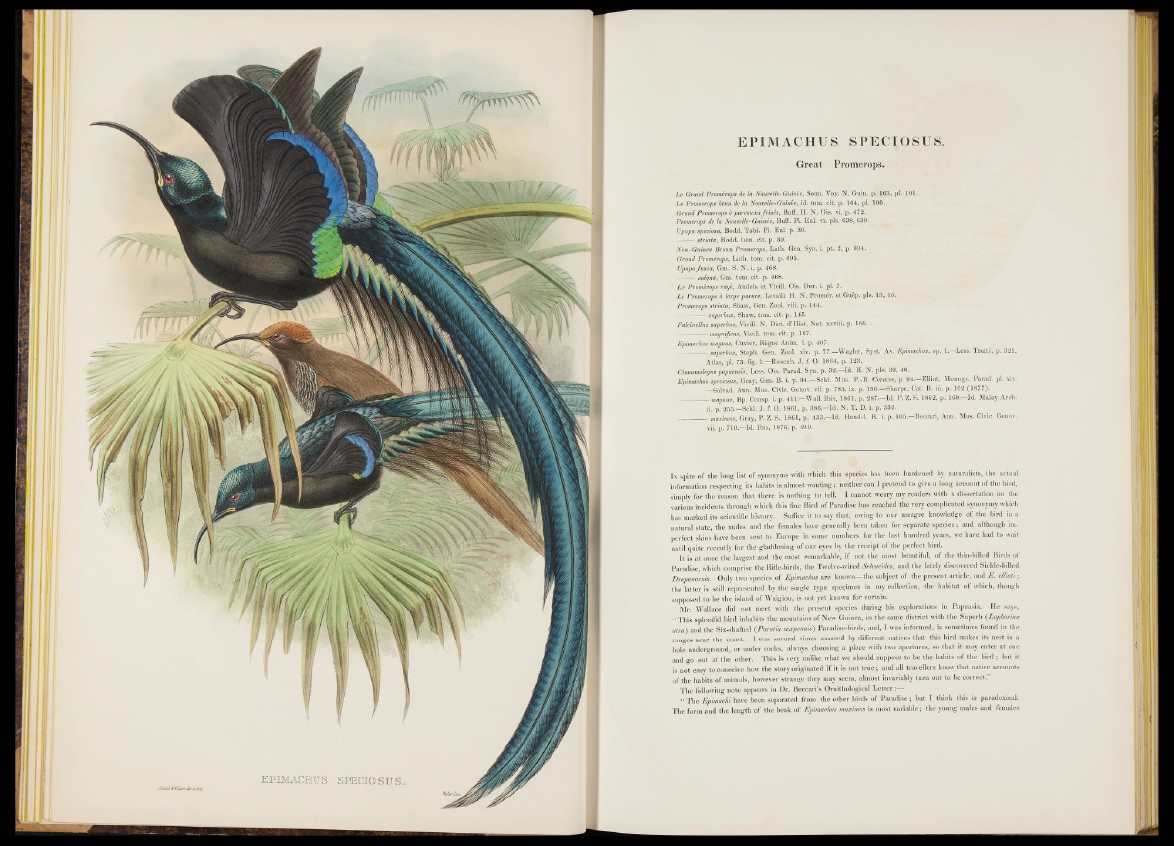
EPIMACHUS SPECIOSUS.
Great Promerops.
Le Grand Promérops de la Nouvelle-Guinée, Soan. Voy. N. Guin. p. 163, pl. 101.
Le Promerops brun de la Nouvelle-Guinée, id. tom. cit. p. 164, pl. 100.
Grand Promerops à paremens frisé s, Buff. H. N. Ois. vi. p. 472.
Promerops de la Nouvelle-Guinée, Buff. Pl. Enl. vi. pis. 638, 639.
Upupa speciosa, Bodd. Tabl. Pl. Enl. p. 39.
- — striata, Bodd. tom. cit. p. 39.
New-Guinea Brown Promerops, Lath. Gen. Syn. i. pt. 2, p. 694.
Grand Promerops, Lath. tom. cit. p. 696.
Upupa fusca, Gm. S. N. i. p. 468.
magna, Gm. tom. cit. p. 468.
Le Promérops rayé, Audeb. et Vieill. Ois. Dor. i. pl. 7.
Le Promerops à large parure, Levaill. H. N . Promér. etGuep. pis. 13, 15.
Promerops striata, Shaw, Gen. Zool. viii. p. 144.
-----------superbus, Shaw, tom. cit. p. 145.
Falcinellus superbus, Vieill. N. Diet. d’Hist. Nat. xxviii. p. 166.
---------------magnifions, Vieill. tom. cit. p. 167.
Epimachus magnus, Cuvier, Règne Anim. i. p. 407.
_________ mperlus, Steph. Gen. Zool. O r . p. 77.—Wagler, Syst. Av. Epimachus, sp. 1 —Less. Traité, p. 321,
Atlas, pl. 73. fig. 1 —Rosenb. J. f. 0 . 1864, p. 123.
Cinnamolegus papuensis, Less. Ois. Parad. Syn. p. 32. Id. H. N. pis. 39, 40.
Epimachus speciosus, Gray, Gen. B. i. p. 9 4 .-S c h l. Mus. P.-B. Coraces, p. 94.—Elliot, Monogr. Parad. pl. xix.
—Salvad. Arm. Mus. Civic. Genov, vil. p. 785, ix. p. 190.—Sharpe, Cat. B. iii. p. 162 (1 8 7 7 |,
magnus, Bp. Consp. i. p. 411.—Wall. Ibis' 1861, p. 287.—Id.. P. Z. Si 1862, p. 160.—Id. Malay Arch.
ii; p . 255.—SeM, J. t. O. 1861, p. 386.—Id . N. T. D. i. p. 332.
________maximus, Gray, P. Z. S. 1861, p . 433.—Id. Hand-1. B. i. p. 105.—Beccari, Ann. Mus. Civic. Genov.
vii. p. 710.—Id. Ibis, 1876, p. 249.
In spite o f the long list o f synonyms with which this species has been burdened by naturalists, the actual
information respecting its habits is almost wanting; neither can I pretend to give a long account o f the bird,
simply for the reason that there is nothing to tell. I cannot weary my readers with a dissertation on the
various incidents through which this line Bird of Paradise has reached the very complicated synonymy which
has marked its scientific history. Suffice it to say that, owing to our meagre knowledge of the bird in a
natural state, the males and the females have generally been taken for separate species; and although imperfect
skins have been sent to Europe in some numbers for the last hundred years, we have had to wait
until quite recently for the gladdening o f our eyes by the receipt o f the perfect bird.
It is at once the largest and the most remarkable, if not the most beautiful, of the thin-billed Birds ot
Paradise, which comprise the Rifle-birds, the Twelve-wired Seleucides, and the lately discovered Sickle-billed
Drepanornis. Only two species of Epimachus are known— the subject of the present article, and E . ellioti;
the latter is still represented by the single type specimen in my collection, the habitat o f which, though
supposed to be the island of Walgiou, is not yet known for certain.
Mr. Wallace did not meet with the present species during his explorations in Papuasia. He says,
“ This splendid bird inhabits the mountains o f New Guinea, in the same district with the Superb (Laplmrina
atra') and the Six-shafted (Parotia sexpmrm) Paradise-birds, and, I was informed, is sometimes found in the
ranges near the coast. I was several times assured by different natives that this bird makes its nest in a
hole underground, or under rocks, always choosing a place with two apertures, so that it may enter at one
and go out at the other. This is very unlike what we should suppose to be the habits o f the bird ; but it
is not easy to conceive how the story originated if it is not true; and all travellers know that native accounts
o f the habits o f animals, however strange they may seem, almost invariably turn out to be correct.”
The following note appears in Dr. Beccari’s Ornithological Letter
“ The Epimachi have been separated from the other birds o f Paradise; but I think this is paradoxical^
The form and the length o f the beak of Epimachus mmimus is most variable; the young males and females